Der europäische Markt für Biostimulanzien soll von 1,83 Milliarden US-Dollar im Jahr 2024 auf 2,60 Milliarden US-Dollar im Jahr 2031 anwachsen. Von 2025 bis 2031 wird ein durchschnittliches jährliches Wachstum (CAGR) von 5,4 % erwartet. Die technologischen Fortschritte in der Entwicklung von Biostimulanzien werden voraussichtlich neue Trends auf dem europäischen Markt für Biostimulanzien mit sich bringen.
Biostimulanzien Marktanalyse für Europa
Da Verbraucher in ganz Europa gesundheitsbewusster werden und sich der Umweltauswirkungen der konventionellen Landwirtschaft bewusst sind, gewinnen Bioprodukte stark an Bedeutung. Bio-Lebensmittel gelten als gesündere, sicherere und umweltfreundlichere Alternative, da sie frei von synthetischen Chemikalien und Pestiziden sind. Diese wachsende Präferenz hat Landwirte und Agrarunternehmen dazu veranlasst, innovative Lösungen zur Verbesserung der Ernteerträge zu entwickeln. Der Übergang zu nachhaltigen landwirtschaftlichen Praktiken hat den Einsatz von Biostimulanzien verstärkt. Biostimulanzien aus Algenextrakten, Aminosäuren, Huminstoffen, Mikroorganismen und anderen natürlichen Extrakten steigern die Leistungsfähigkeit von Pflanzen, indem sie ihre Widerstandsfähigkeit gegen Umweltbelastungen wie hohe Temperaturen, Dürre und Bodenversalzung verbessern. Zu den am weitesten verbreiteten mikrobiellen Biostimulanzien zählen arbuskuläre Mykorrhizapilze, Trichoderma-Pilze und Rhizosphärenbakterien (pflanzenwachstumsfördernde Rhizobakterien). Diese Mikroorganismen gehen symbiotische Beziehungen mit Pflanzen ein und verbessern so deren allgemeine Gesundheit und Produktivität.
Marktübersicht für Biostimulanzien in Europa
In Europa werden Biostimulanzien zur Bodenverbesserung in Düngemitteln eingesetzt, da sie die Bodenfruchtbarkeit und das Wasserhaltevermögen verbessern. Der Vertrieb erfolgt in der Region sowohl online als auch offline. Das Wachstum des Online-Handels hat Biostimulanzien für Getreide, Körner sowie Garten- und Landschaftsbau leicht verfügbar gemacht. Dies ist einer der wichtigsten Faktoren für das Wachstum des Biostimulanzienmarktes in der Region. Landwirte in der Region erkennen zunehmend die Vorteile der Integration von Biostimulanzien in ihre landwirtschaftlichen Praktiken, um die Bodengesundheit zu verbessern, die Ernteerträge zu steigern und die Auswirkungen des Klimawandels zu mildern. Staatliche Maßnahmen zur Förderung einer nachhaltigen Landwirtschaft, wie beispielsweise das Environmental Land Management Scheme, bieten Landwirten finanzielle Anreize für den Einsatz von Biostimulanzien als Bodenverbesserungsmittel.
Sie erhalten kostenlos Anpassungen an jedem Bericht, einschließlich Teilen dieses Berichts oder einer Analyse auf Länderebene, eines Excel-Datenpakets sowie tolle Angebote und Rabatte für Start-ups und Universitäten
Europäischer Markt für Biostimulanzien:
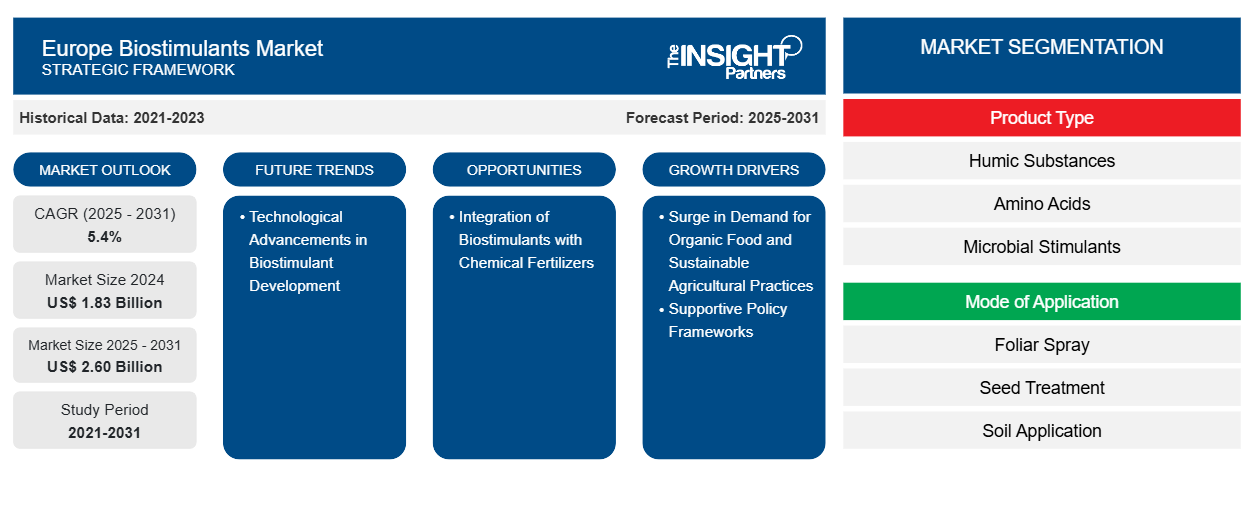
- Informieren Sie sich über die wichtigsten Markttrends in diesem Bericht.Dieses KOSTENLOSE Beispiel umfasst Datenanalysen, von Markttrends bis hin zu Schätzungen und Prognosen.
Treiber und Chancen des europäischen Marktes für Biostimulanzien
Unterstützende politische Rahmenbedingungen
Die Europäische Union hat die Einführung von Biostimulanzien durch regulatorische Rahmenbedingungen unterstützt, die ihren sicheren und wirksamen Einsatz in der Landwirtschaft gewährleisten. Die Europäische Union hat klare regulatorische Rahmenbedingungen zur Regelung der Verwendung von Biostimulanzien geschaffen. Die EU-Verordnung 1107/2009 (die Pflanzenschutzmittel abdeckt) und die neuere Verordnung (EU) 2019/1009 über Biostimulanzien bieten klare Richtlinien für Biostimulanzien und gewährleisten deren Sicherheit und Wirksamkeit. Diese regulatorische Klarheit hat zu einer stärkeren Einführung von Biostimulanzien durch Landwirte in ganz Europa geführt. Darüber hinaus priorisiert der europäische Green Deal mit seiner Strategie „Vom Hof auf den Tisch“ eine verbesserte Ressourceneffizienz, eine saubere Kreislaufwirtschaft, die Wiederherstellung der biologischen Vielfalt und die Reduzierung der Umweltverschmutzung. Dieser Schritt in Richtung Nachhaltigkeitsziele treibt die Nachfrage nach umweltfreundlichen landwirtschaftlichen Produkten, einschließlich Biostimulanzien, an, um das Ziel zu erreichen, Europa bis 2050 zur ersten klimaneutralen Region zu machen.
Integration von Biostimulanzien mit chemischen Düngemitteln
Durch die Kombination von Biostimulanzien mit chemischen Düngemitteln lässt sich nachhaltiges Ressourcenmanagement erreichen, da es die Nährstoffaufnahme optimiert, ein robustes Pflanzenwachstum fördert und möglicherweise die Abhängigkeit von synthetischen Düngemitteln reduziert . Diese Strategie kann auch zu einer geringeren Umweltbelastung durch übermäßigen Düngemitteleinsatz führen. Biostimulanzien erfordern zwar im Vergleich zu bestimmten herkömmlichen chemischen Düngemitteln höhere Anfangsinvestitionen, ihre agronomischen und wirtschaftlichen Vorteile – wie höhere Erträge und bessere Gewinne für die Landwirte – können jedoch langfristig eine höhere Kapitalrendite erzielen. So ergab beispielsweise eine im Italian Journal of Agronomy veröffentlichte Studie über Hartweizen, dass die Anwendung von Biostimulanzien wichtige morphophysiologische Parameter und den Kornertrag erheblich steigern und gleichzeitig die Abhängigkeit von synthetischen Stickstoffdüngern reduzieren kann. Die genannten Vorteile dürften daher die Nutzung von Biostimulanzien fördern und somit das Marktwachstum in den kommenden Jahren vorantreiben.
Segmentierungsanalyse des europäischen Marktberichts zu Biostimulanzien
Wichtige Segmente, die zur Ableitung der europäischen Marktanalyse für Biostimulanzien beigetragen haben , sind Produkttyp, Anwendungsart und Pflanzenart.
- Basierend auf dem Produkttyp ist der Markt in Huminstoffe, Aminosäuren , mikrobielle Stimulanzien, Algenextrakte und andere segmentiert. Das Segment Algenextrakte hielt im Jahr 2024 den größten Marktanteil.
- Hinsichtlich der Anwendungsart ist der Markt in Blattspray, Saatgutbehandlung und Bodenanwendung segmentiert. Das Blattspray-Segment hielt im Jahr 2024 den größten Marktanteil.
- Basierend auf der Anbauart ist der Markt in Getreide und Körner, Ölsaaten und Hülsenfrüchte, Obst und Gemüse, Rasen und Landschaftsbau usw. unterteilt. Das Segment Getreide und Körner hatte im Jahr 2024 den größten Marktanteil.
Analyse der Marktanteile von Biostimulanzien in Europa nach geografischen Gesichtspunkten
Der Umfang des europäischen Marktberichts zu Biostimulanzien konzentriert sich auf das Marktszenario im Hinblick auf historische Marktumsätze und Prognosen.
Geografisch unterteilt sich der europäische Markt für Biostimulanzien in Deutschland, Großbritannien, Frankreich, Italien, Russland und das übrige Europa. Frankreich hatte 2024 den größten Marktanteil, und Großbritannien wird im Prognosezeitraum voraussichtlich die höchste jährliche Wachstumsrate (CAGR) aufweisen. Dies ist auf die zunehmend nachhaltige und biologische Landwirtschaft in diesen Ländern zurückzuführen. Förderliche staatliche Unterstützung und Initiativen werden ebenfalls zum Marktwachstum in Großbritannien beitragen.
Europa Biostimulanzien
Regionale Einblicke in den europäischen Markt für Biostimulanzien
Die Analysten von Insight Partners haben die regionalen Trends und Faktoren, die den europäischen Biostimulanzienmarkt im Prognosezeitraum beeinflussen, ausführlich erläutert. In diesem Abschnitt werden auch die europäischen Biostimulanzienmarktsegmente und die geografische Lage in Nordamerika, Europa, Asien-Pazifik, dem Nahen Osten und Afrika sowie Süd- und Mittelamerika erörtert.
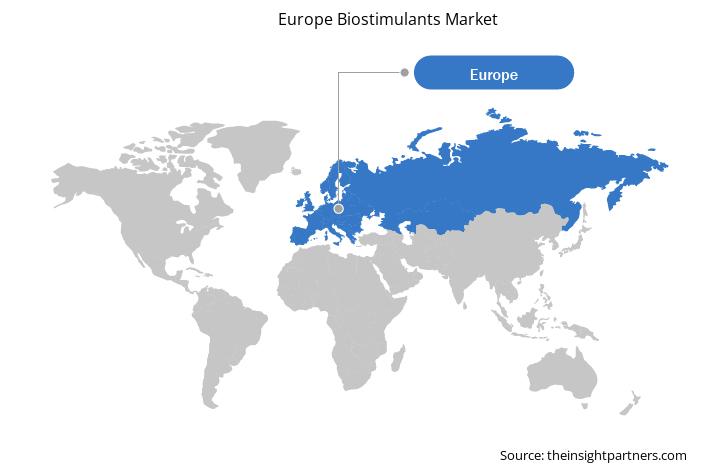
- Erhalten Sie regionale Daten zum europäischen Markt für Biostimulanzien
Umfang des Marktberichts zu Biostimulanzien in Europa
| Berichtsattribut | Details |
|---|---|
| Marktgröße im Jahr 2024 | 1,83 Milliarden US-Dollar |
| Marktgröße bis 2031 | 2,60 Milliarden US-Dollar |
| Globale CAGR (2025 – 2031) | 5,4 % |
| Historische Daten | 2021-2023 |
| Prognosezeitraum | 2025–2031 |
| Abgedeckte Segmente | Nach Produkttyp
|
| Abgedeckte Regionen und Länder | Europa
|
| Marktführer und wichtige Unternehmensprofile |
|
Dichte der Akteure auf dem europäischen Markt für Biostimulanzien: Verständnis ihrer Auswirkungen auf die Geschäftsdynamik
Der europäische Markt für Biostimulanzien wächst rasant. Die steigende Endverbrauchernachfrage ist auf Faktoren wie veränderte Verbraucherpräferenzen, technologische Fortschritte und ein stärkeres Bewusstsein für die Produktvorteile zurückzuführen. Mit der steigenden Nachfrage erweitern Unternehmen ihr Angebot, entwickeln Innovationen, um den Verbraucherbedürfnissen gerecht zu werden, und nutzen neue Trends, was das Marktwachstum weiter ankurbelt.
Die Marktteilnehmerdichte beschreibt die Verteilung der in einem bestimmten Markt oder einer bestimmten Branche tätigen Unternehmen. Sie gibt an, wie viele Wettbewerber (Marktteilnehmer) in einem bestimmten Marktraum im Verhältnis zu dessen Größe oder Gesamtmarktwert präsent sind.
Die wichtigsten Unternehmen auf dem europäischen Markt für Biostimulanzien sind:
- Nichino Europe Co Ltd
- Syngenta AG
- BASF SE
- UPL Ltd
- FMC Corp
- Russell IPM Ltd
Haftungsausschluss : Die oben aufgeführten Unternehmen sind nicht in einer bestimmten Reihenfolge aufgeführt.
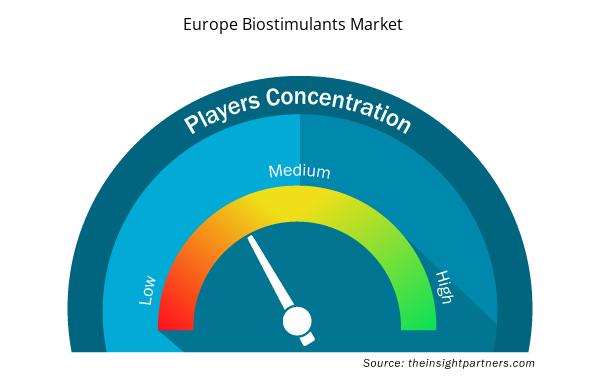
- Überblick über die wichtigsten Akteure auf dem europäischen Markt für Biostimulanzien
Neuigkeiten und aktuelle Entwicklungen zum europäischen Biostimulanzienmarkt
Der europäische Markt für Biostimulanzien wird durch die Erhebung qualitativer und quantitativer Daten aus Primär- und Sekundärforschung bewertet. Dazu zählen wichtige Unternehmenspublikationen, Verbandsdaten und Datenbanken. Nachfolgend sind einige Entwicklungen auf dem europäischen Markt für Biostimulanzien aufgeführt:
- Nichino Europe Co Ltd (Nichino) hat Interagro (UK) Limited (Interagro) übernommen. Nichino erwarb das gesamte Aktienkapital von Interagro (UK) Limited. Die Übernahme soll das Produktportfolio von Nichino und Interagro für ihre aktuellen und zukünftigen Kunden erweitern. (Quelle: Nichino Europe Co Ltd, Pressemitteilung, April 2023)
- IntraCrop besuchte Griechenland, um die Beziehungen zu NitroFarm, ihrem Hauptvertriebspartner, zu stärken und mit Vertriebsmitarbeitern die Positionierung von Biostimulanzien zu besprechen. (Quelle: IntraCrop, Pressemitteilung, Februar 2025)
- Syngenta und TraitSeq haben zusammengearbeitet, um die Forschung und Entwicklung von Biostimulanzien zu beschleunigen. Dabei nutzen sie KI, um innovative, leistungsstarke Biostimulanzien für eine nachhaltige Landwirtschaft zu entwickeln, die ein entscheidender Faktor für die Förderung des Pflanzenwachstums ist. (Quelle: Syngenta, Pressemitteilung, Januar 2025)
Bericht zum europäischen Markt für Biostimulanzien – Umfang und Ergebnisse
Der Bericht „Marktgröße und Prognose für Biostimulanzien in Europa (2021–2031)“ bietet eine detaillierte Analyse des Marktes, die die folgenden Bereiche abdeckt:
- Größe und Prognose des europäischen Biostimulanzienmarktes auf Länderebene für alle wichtigen Marktsegmente, die im Rahmen des Geltungsbereichs abgedeckt sind
- Markttrends für Biostimulanzien in Europa sowie Marktdynamiken wie Treiber, Beschränkungen und wichtige Chancen
- Detaillierte Porter's Five Forces und SWOT-Analyse
- Analyse des europäischen Marktes für Biostimulanzien mit wichtigen Markttrends, Länderrahmen, wichtigen Akteuren, Vorschriften und aktuellen Marktentwicklungen
- Branchenlandschaft und Wettbewerbsanalyse mit Marktkonzentration, Heatmap-Analyse, prominenten Akteuren und jüngsten Entwicklungen für den europäischen Markt für Biostimulanzien
- Detaillierte Firmenprofile
- Historische Analyse (2 Jahre), Basisjahr, Prognose (7 Jahre) mit CAGR
- PEST- und SWOT-Analyse
- Marktgröße Wert/Volumen – Global, Regional, Land
- Branche und Wettbewerbsumfeld
- Excel-Datensatz
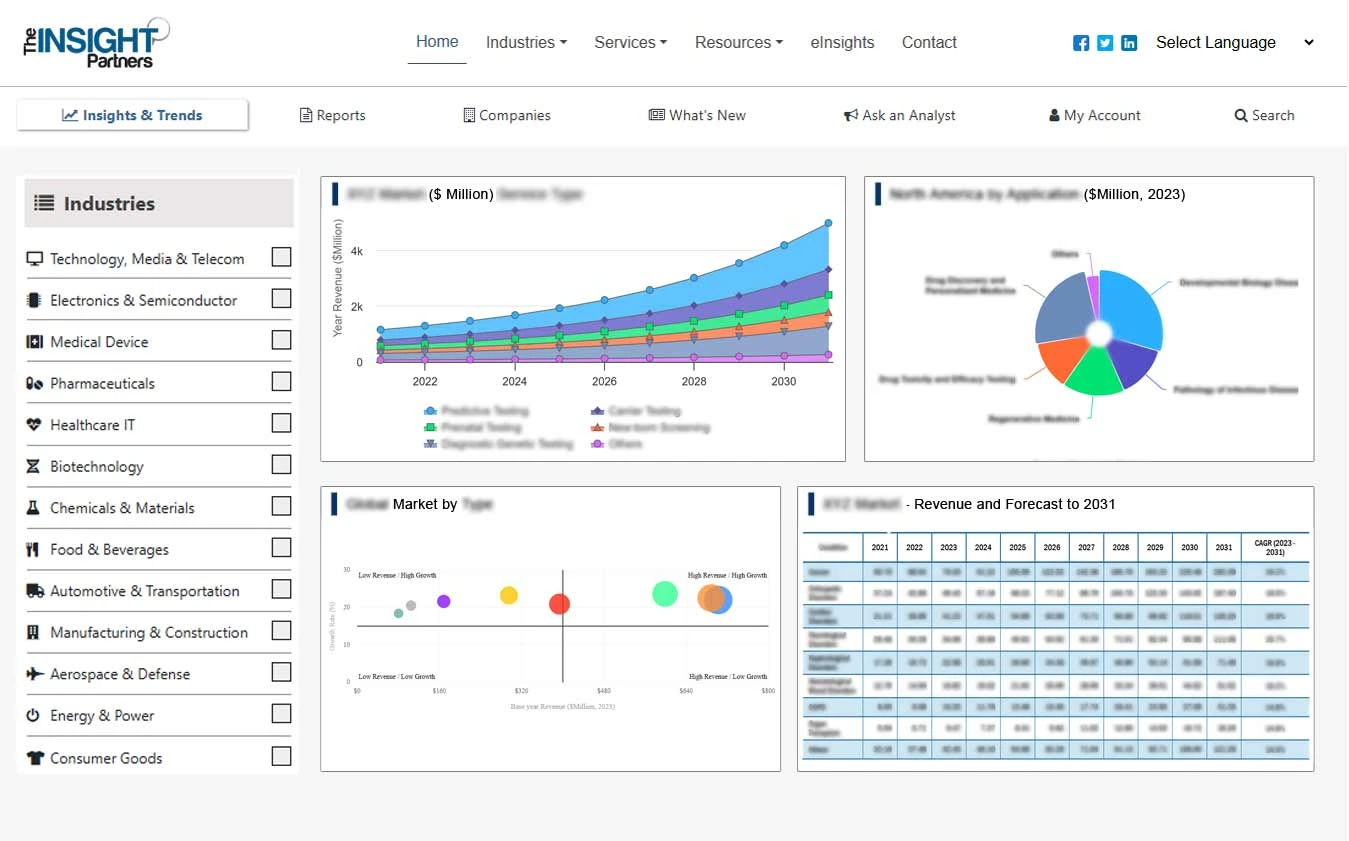
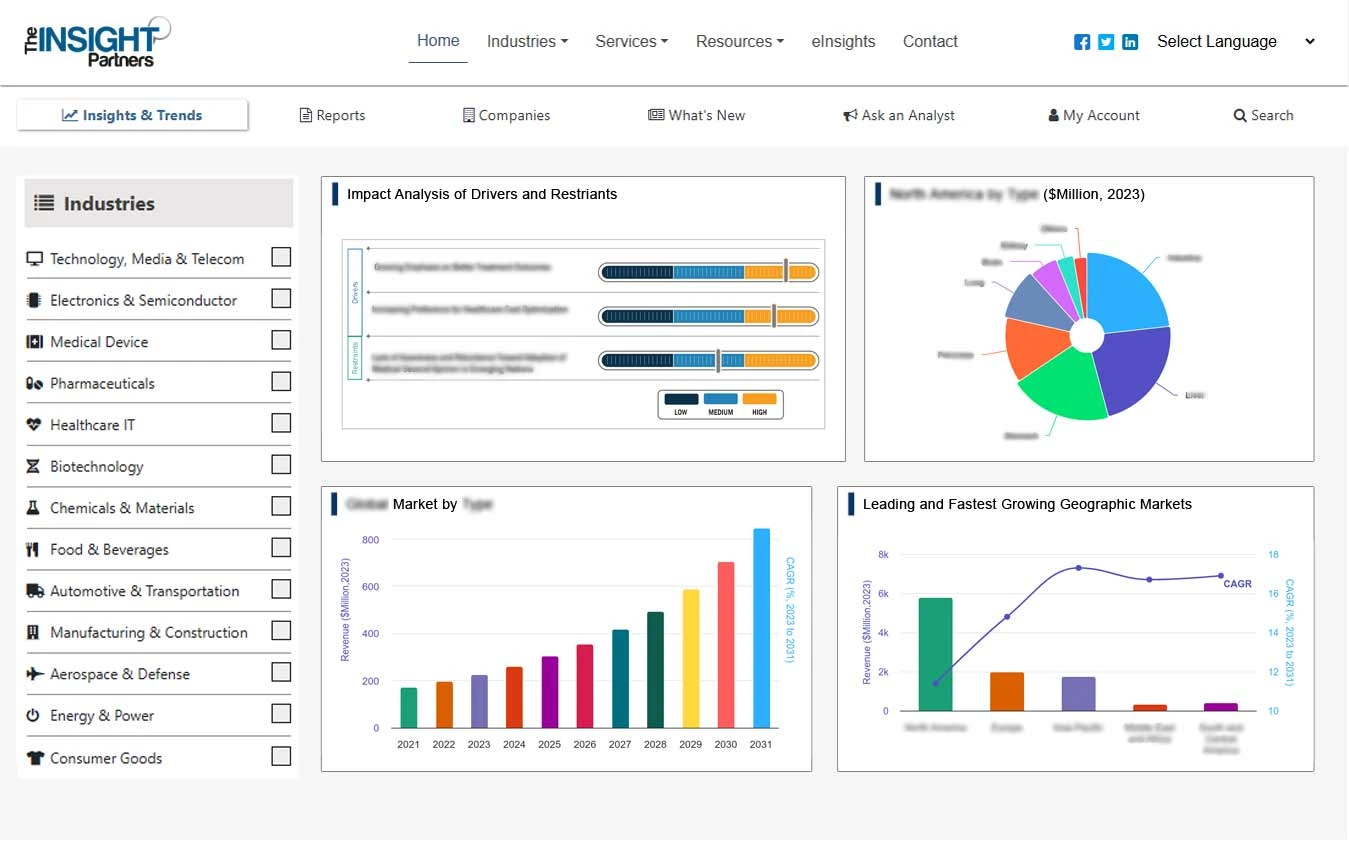

Report Coverage
Revenue forecast, Company Analysis, Industry landscape, Growth factors, and Trends

Segment Covered
This text is related
to segments covered.
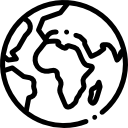
Regional Scope
North America, Europe, Asia Pacific, Middle East & Africa, South & Central America

Country Scope
This text is related
to country scope.
Häufig gestellte Fragen
The seaweed extracts segment dominated the market in 2024.
The surge in demand for organic food and sustainable agricultural practices and the supportive policy frameworks are among the factors driving the market growth.
The technological advancements in biostimulant development are likely to bring in new trends in the Europe biostimulants market.
Nichino Europe Co Ltd, Syngenta AG, BASF SE, UPL Ltd, FMC Corp, Russell IPM Ltd, Sipcam UK Ltd, IntraCrop Ltd, Bionema Ltd, and Central Pharma Contract Packing Ltd are among the key players operating in the Europe biostimulants market.
The market is estimated to register a CAGR of 5.4% during 2025–2031.
The market is projected to reach US$ 2.60 million by 2031.
The List of Companies - Europe Biostimulants Market
- Nichino Europe Co Ltd
- Syngenta AG
- BASF SE
- UPL Ltd
- FMC Corp
- Russell IPM Ltd
- Sipcam UK Ltd
- IntraCrop Ltd
- Bionema Ltd
- Central Pharma Contract Packing Ltd
The Insight Partners performs research in 4 major stages: Data Collection & Secondary Research, Primary Research, Data Analysis and Data Triangulation & Final Review.
- Data Collection and Secondary Research:
As a market research and consulting firm operating from a decade, we have published and advised several client across the globe. First step for any study will start with an assessment of currently available data and insights from existing reports. Further, historical and current market information is collected from Investor Presentations, Annual Reports, SEC Filings, etc., and other information related to company’s performance and market positioning are gathered from Paid Databases (Factiva, Hoovers, and Reuters) and various other publications available in public domain.
Several associations trade associates, technical forums, institutes, societies and organization are accessed to gain technical as well as market related insights through their publications such as research papers, blogs and press releases related to the studies are referred to get cues about the market. Further, white papers, journals, magazines, and other news articles published in last 3 years are scrutinized and analyzed to understand the current market trends.
- Primary Research:
The primarily interview analysis comprise of data obtained from industry participants interview and answers to survey questions gathered by in-house primary team.
For primary research, interviews are conducted with industry experts/CEOs/Marketing Managers/VPs/Subject Matter Experts from both demand and supply side to get a 360-degree view of the market. The primary team conducts several interviews based on the complexity of the markets to understand the various market trends and dynamics which makes research more credible and precise.
A typical research interview fulfils the following functions:
- Provides first-hand information on the market size, market trends, growth trends, competitive landscape, and outlook
- Validates and strengthens in-house secondary research findings
- Develops the analysis team’s expertise and market understanding
Primary research involves email interactions and telephone interviews for each market, category, segment, and sub-segment across geographies. The participants who typically take part in such a process include, but are not limited to:
- Industry participants: VPs, business development managers, market intelligence managers and national sales managers
- Outside experts: Valuation experts, research analysts and key opinion leaders specializing in the electronics and semiconductor industry.
Below is the breakup of our primary respondents by company, designation, and region:

Once we receive the confirmation from primary research sources or primary respondents, we finalize the base year market estimation and forecast the data as per the macroeconomic and microeconomic factors assessed during data collection.
- Data Analysis:
Once data is validated through both secondary as well as primary respondents, we finalize the market estimations by hypothesis formulation and factor analysis at regional and country level.
- Macro-Economic Factor Analysis:
We analyse macroeconomic indicators such the gross domestic product (GDP), increase in the demand for goods and services across industries, technological advancement, regional economic growth, governmental policies, the influence of COVID-19, PEST analysis, and other aspects. This analysis aids in setting benchmarks for various nations/regions and approximating market splits. Additionally, the general trend of the aforementioned components aid in determining the market's development possibilities.
- Country Level Data:
Various factors that are especially aligned to the country are taken into account to determine the market size for a certain area and country, including the presence of vendors, such as headquarters and offices, the country's GDP, demand patterns, and industry growth. To comprehend the market dynamics for the nation, a number of growth variables, inhibitors, application areas, and current market trends are researched. The aforementioned elements aid in determining the country's overall market's growth potential.
- Company Profile:
The “Table of Contents” is formulated by listing and analyzing more than 25 - 30 companies operating in the market ecosystem across geographies. However, we profile only 10 companies as a standard practice in our syndicate reports. These 10 companies comprise leading, emerging, and regional players. Nonetheless, our analysis is not restricted to the 10 listed companies, we also analyze other companies present in the market to develop a holistic view and understand the prevailing trends. The “Company Profiles” section in the report covers key facts, business description, products & services, financial information, SWOT analysis, and key developments. The financial information presented is extracted from the annual reports and official documents of the publicly listed companies. Upon collecting the information for the sections of respective companies, we verify them via various primary sources and then compile the data in respective company profiles. The company level information helps us in deriving the base number as well as in forecasting the market size.
- Developing Base Number:
Aggregation of sales statistics (2020-2022) and macro-economic factor, and other secondary and primary research insights are utilized to arrive at base number and related market shares for 2022. The data gaps are identified in this step and relevant market data is analyzed, collected from paid primary interviews or databases. On finalizing the base year market size, forecasts are developed on the basis of macro-economic, industry and market growth factors and company level analysis.
- Data Triangulation and Final Review:
The market findings and base year market size calculations are validated from supply as well as demand side. Demand side validations are based on macro-economic factor analysis and benchmarks for respective regions and countries. In case of supply side validations, revenues of major companies are estimated (in case not available) based on industry benchmark, approximate number of employees, product portfolio, and primary interviews revenues are gathered. Further revenue from target product/service segment is assessed to avoid overshooting of market statistics. In case of heavy deviations between supply and demand side values, all thes steps are repeated to achieve synchronization.
We follow an iterative model, wherein we share our research findings with Subject Matter Experts (SME’s) and Key Opinion Leaders (KOLs) until consensus view of the market is not formulated – this model negates any drastic deviation in the opinions of experts. Only validated and universally acceptable research findings are quoted in our reports.
We have important check points that we use to validate our research findings – which we call – data triangulation, where we validate the information, we generate from secondary sources with primary interviews and then we re-validate with our internal data bases and Subject matter experts. This comprehensive model enables us to deliver high quality, reliable data in shortest possible time.
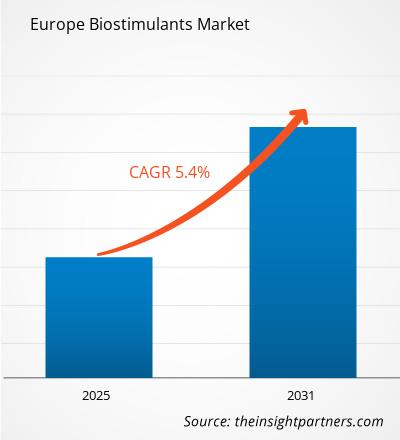
 Holen Sie sich ein kostenloses Muster für diesen Bericht
Holen Sie sich ein kostenloses Muster für diesen Bericht